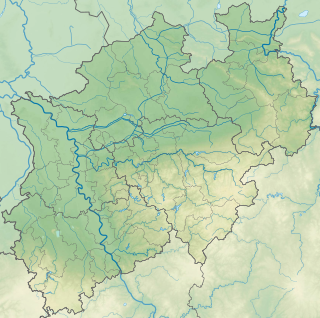Niederberg hillside terraces
| Niederberg hillside terraces | |||
|---|---|---|---|
| Aerial view of Heiligenhaus | |||
| Systematics according to | Handbook of the natural spatial structure of Germany | ||
| Greater region 1st order | Low mountain range threshold | ||
| Greater region 2nd order | Rhenish Slate Mountains | ||
| Main unit group | 33 → Süderbergland |
||
| About main unit | 337 → Bergisch-Sauerland lowlands |
||
| 4th order region (main unit) |
337 1 → Niederbergisch-Märkisches hill country |
||
| Natural space |
337 1 .0 → Niederbergische Höhenterrassen |
||
| Geographical location | |||
| Coordinates | 51 ° 15 ′ 0 ″ N , 6 ° 58 ′ 0 ″ E | ||
|
|||
| local community | Düsseldorf , Mülheim an der Ruhr | ||
| circle | Mettmann district | ||
| state | North Rhine-Westphalia | ||
| Country | Germany | ||
With low Bergische height terraces one is natural spatial unit (order number 337 1 .0) of over-head unit Bergisch-Sauerländisches lowlands called (atomic number 337).
It covers the parts of the Niederbergisches Land between Haan in the south and the Ruhr valley (order number 337 1 .2) in the north. In the east, the elevated terraces rise to the Bergisch-Märkisches Hügelland (order number 337 1 .1), in the west they merge into the over-main unit Bergische Heideterrasse (order number 550). The most famous landscape in the natural area is the Neandertal .
The cities and municipalities with a share of the hillside terraces include Ratingen (districts of Breitscheid , Hösel , Eggerscheidt , Homberg-Meiersberg and Schwarzbach ), Mülheim an der Ruhr (district of Saarn ), Heiligenhaus , Velbert (western edge), Wülfrath (western edge), Mettmann , Düsseldorf (districts Gerresheim , Ludenberg , Hubbelrath and Rath ), parts of Erkrath (without town center) and Haan- Gruiten (without Gruiten-Dorf).
The Niederbergische Höhenterrassen consist of old diluvial high valley floors of the Rhine on the western edge of the Rhenish Slate Mountains . In the west, the terraces are roofed towards the west. In the east, on the other hand, the hilly terrain is very steep and consists of folded Carboniferous or Devonian rocks. The highest heights are found in the southeast at 300 m, the deepest lowlands are at 100 m in the northwest. This altitude gradient creates a strong damming effect of maritime air masses, which leads to high annual precipitation amounts between 800 and 1100 mm, especially in Wuppertal and Schwelm . The maximum of the precipitation lies in the west of the natural area in summer, in the east two-peaked maxima are measurable in July and December.
structure
The Niederberg hill terraces are divided into subordinate natural areas.
- 337 1 .0 Niederberg hill terraces
- 337 1 .00 Mettmann loess terraces
- 337 1 .01 Heiligenhauser Terraces
- 337 1 .03 Selbecker Terrassenland

